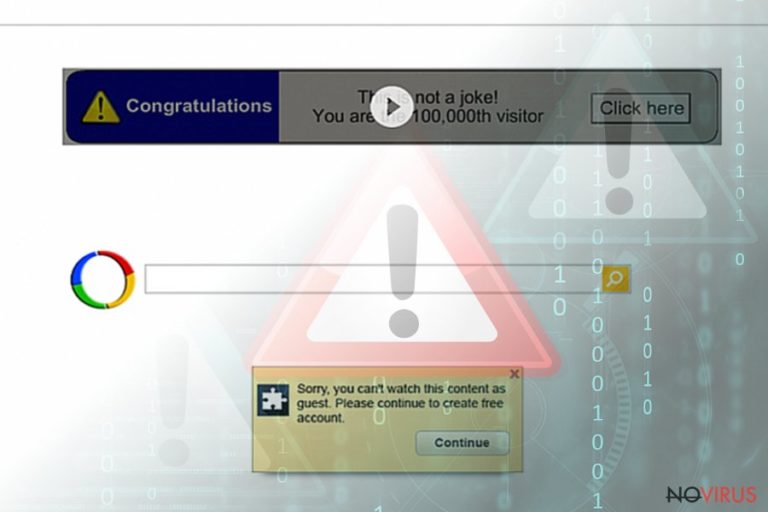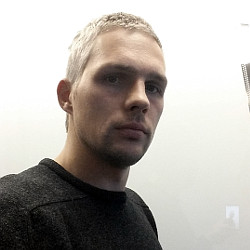Uninstall Google redirect (Virus Removal Instructions) - Aug 2017 updated
Google redirect Removal Guide
Description of Google redirect
What problems can cause Google redirect virus?

Google redirect virus is similar to Yahoo Redirect virus and Bing redirect virus and is classified as a browser hijacker. It is created for delivering sponsored content and redirecting users to various websites. As the name of the infections informs, virus initiates redirects to Google.com. However, it can also redirect users to other search engines, such as Yahoo or Bing, and other websites.
Redirects are not only annoying and disturbing, but also might lead to weird or malicious websites, such as pornographic sites, gambling sites or various online shops. Another symptom of Google redirect infection is altered browser’s settings. Once you open an infected browser, you might notice that homepage, new tab or default search engine were changed. What is more, it can modify bookmarks and install various tools to the browser without asking user’s permission.
Virus targets both, Windows and Mac operating systems, and affects web browsers such as Google Chrome, Internet Explorer, Mozilla Firefox, Safari, etc. Usually, the browser hijacker travels and enters computer system with a help of regular software installers, so users rarely notice when the hijack occurs.
However, when you notice the hijack, remove Google redirect immediately. Redirect viruses are tricky and might hide under different names, so they might be hard to find manually. For this reason, we recommend using anti-malware tools (e.g., FortectIntego or SpyHunter 5Combo Cleaner) and eliminating infection automatically.
Millions of computer users all over the world have already faced Google redirect problem. Even though Google is legitimate and safe to use a search engine, the creators of browser hijacker use customised Google search (they might also use customized Yahoo, Bing or unknown search providers). It means the search results are altered. The purpose of the browser hijacker is to generate revenue from affiliate marketing.
For this reason, search results are filled with sponsored links. These links might lead to irrelevant and high-risk websites. By entering these Internet sites, you might accidentally install malware, Trojan or virus. You should initiate Google redirect removal to protect your computer from further infections.
Also, the virus can fill the browser with various ads that offer great deals, discount coupons or software downloads. No matter how great deal looks, do not consider clicking on it, because they might be malicious as well. Another problem with Google redirect browser hijacker is that it might be capable of collecting information related to users browsing habits and history. It can monitor what websites you visit, how much time you spend there, what search queries you enter, what’s your IP address or location, and other similar information.

Distribution techniques
The risk of computer infection increases if you do not use any antivirus program. For computer’s protection, you should use reliable and powerful security program and watch your actions online. Any program cannot protect your computer 100% if you do not act wisely online.
The creators of Google redirect virus use the same old deceptive software marketing technique – ‘bundling.’ The browser hijacker is added as an optional download and hidden under ‘Quick’ or ‘Recommended’ installation mode. So, for software installation, you have to choose ‘Advanced’ or ‘Custom’ setup. This method allows preventing the computer from Google redirect hijack and other PUPs from getting inside the system.
Getting rid of Google redirect problem
Google redirect virus removal consists of two steps. First, you have to detect and remove browser hijacker from the computer. Second, you have to uninstall suspicious browser extensions, toolbars or add-ons. You can complete this task manually; however, we have to remind you that virus is capable of hiding itself and this feature makes it hard to find and eliminate.
For this reason, we recommend getting rid of this computer infection automatically. To remove Google redirect automatically, you have to employ malware removal tools and scan computer’s system. Once the program finishes its job, you can reset browser’s settings and get back to the regular browsing.
You may remove virus damage with a help of FortectIntego. SpyHunter 5Combo Cleaner and Malwarebytes are recommended to detect potentially unwanted programs and viruses with all their files and registry entries that are related to them.
Getting rid of Google redirect. Follow these steps
Uninstall Google in Windows systems
To remove Google redirect virus you have to find and uninstall browser hijacker from your computer. It can hide under different files names, so it might be hard to find. For this reason, we recommend scanning computer’s system with a reputable anti-malware program such as FortectIntego.
Terminate suspicious programs from Windows 10/8 machines by following these instructions:
- Type Control Panel into Windows search and once the result shows up hit Enter.
- Under Programs, choose Uninstall a program.

- Find components related to suspicious programs.
- Right-click on the application and select Uninstall.
- Click Yes when User Account Control shows up.

- Wait for the process of uninstallation to be done and click OK.
Windows 7/XP instructions:
- Click on Windows Start and go to Control Panel on the right pane.
- Choose Add/Remove Programs.

- Select Uninstall a program under Programs in Control Panel.
- Click once on the unwanted application.
- Click Uninstall/Change at the top.
- Confirm with Yes.
- Click OK and finish the removal.
Uninstall Google in Mac OS X system
The browser hijacker might have sneaked into the system when you installed one of the latest programs. Check the list of recent installs. You have to find and uninstall the potentially unwanted program.
-
Users who use OS X should click on Go button, which can be found at the top left corner of the screen and select Applications.

-
Wait until you see Applications folder and look for Google or any other suspicious programs on it. Now right click on every of such entries and select Move to Trash.

Fix Google redirect issue in Microsoft Edge browser
If browser hijacker affected Microsoft Edge, you have to clear all browsing data and reset the browser. Follow these steps presented bellow.
Delete suspicious extensions from MS Edge:
- Go to the Menu by clicking on the three horizontal dots at the top-right.
- Then pick Extensions.

- Choose the unwanted add-ons on the list and click on the Gear icon.
- Click on Uninstall at the bottom.
Clear cookies and other data:
- Click on the Menu and from the context menu select Privacy & security.
- Under Clear browsing data, select Choose what to clear.

- Choose everything except passwords, and click on Clear.
Alter new tab and homepage settings:
- Click the menu icon and choose Settings.
- Then find On startup section.
- Click Disable if you found any suspicious domain.
Reset MS Edge fully:
- Click on the keyboard Ctrl + Shift + Esc to open Task Manager.
- Choose More details arrow at the bottom.
- Go to Details tab.

- Now scroll down and locate every entry with Microsoft Edge name in it.
- Right-click on each of them and select End Task to stop MS Edge from running.
When none of the above solves the issue, you might need an advanced Edge reset method, but you need to backup your data before proceeding.
- Find the following folder on the PC: C:\\Users\\%username%\\AppData\\Local\\Packages\\Microsoft.MicrosoftEdge_8wekyb3d8bbwe.
- Press Ctrl + A on your keyboard to select all folders.

- Right-click on the selection and choose Delete
- Right-click on the Start button and pick Windows PowerShell (Admin).

- Copy and paste the following command, and then press Enter:
Get-AppXPackage -AllUsers -Name Microsoft.MicrosoftEdge | Foreach {Add-AppxPackage -DisableDevelopmentMode -Register “$($_.InstallLocation)\\AppXManifest.xml” -Verbose
Instructions for Chromium-based Edge
Delete extensions:
- Open Edge and click Settings.
- Then find Extensions.

- Delete unwanted extensions with the Remove.
Clear cache and site data:
- Click on Menu and then Settings.
- Find Privacy and services.
- Locate Clear browsing data, then click Choose what to clear.

- Time range.
- Click All time.
- Select Clear now.
Reset Chromium-based MS Edge browser fully:
- Go to Settings.
- On the left side, choose Reset settings.

- Select Restore settings to their default values.
- Click Reset.
Delete Google from Mozilla Firefox (FF)
To get rid of Google redirect problem you have to look through extensions list and remove all suspicious toolbars or add-ons that were installed to the Firefox.
Remove suspicious Firefox extensions:
- Open Mozilla Firefox browser and click on the three horizontal lines at the top-right to open the menu.
- Select Add-ons in the context menu.

- Choose plugins that are creating issues and select Remove.
Reset the homepage on the browser:
- Click three horizontal lines at the top right corner.
- This time select Options.
- Under Home section, enter your preferred site for the homepage that will open every time you launch Mozilla Firefox.
Clear cookies and site data:
- Click Menu and pick Options.
- Find the Privacy & Security section.
- Scroll down to choose Cookies and Site Data.

- Click on Clear Data… option.
- Click Cookies and Site Data, Cached Web Content and press Clear.
Reset Mozilla Firefox:
If none of the steps above helped you, reset Mozilla Firefox as follows:
- Open Mozilla Firefox and go to the menu.
- Click Help and then choose Troubleshooting Information.

- Locate Give Firefox a tune-up section, click on Refresh Firefox…
- Confirm the action by pressing on Refresh Firefox on the pop-up.

Chrome browser reset
Google Chrome is one of the most targeted browsers. You have to check the list of extensions. There you might find several suspicious plugins installed to your browser. You have to find questionable extensions and uninstall them.
Find and remove suspicious extensions from Google Chrome:
- In Google Chrome, open the Menu by clicking three vertical dots at the top-right corner.
- Select More tools > Extensions.
- Once the window opens, you will see all the installed extensions.
- Find any suspicious add-ons related to any PUP.
- Uninstall them by clicking Remove.

Clear cache and web data from Chrome:
- Click the Menu and select Settings.
- Find Privacy and security section.
- Choose Clear browsing data.
- Select Browsing history.
- Cookies and other site data, also Cached images and files.
- Click Clear data.

Alter settings of the homepage:
- Go to the menu and choose Settings.
- Find odd entries in the On startup section.
- Click on Open a specific or set of pages.
- Then click on three dots and look for the Remove option.
Reset Google Chrome fully:
You might need to reset Google Chrome and properly eliminate all the unwanted components:
- Go to Chrome Settings.
- Once there, scroll down to expand Advanced section.
- Scroll down to choose Reset and clean up.
- Click Restore settings to their original defaults.
- Click Reset settings again.

Delete Google from Safari
Look through the list of recently installed extensions. Some suspicious plugins might have been installed without your knowledge. Uninstall all of them.
Get rid of questionable extensions from Safari:
- Click Safari.
- Then go to Preferences…

- Choose Extensions on the menu.
- Select the unwanted extension and then pick Uninstall.
Clear cookies from Safari:
- Click Safari.
- Choose Clear History…

- From the drop-down menu under Clear, find and pick all history.
- Confirm with Clear History.
Reset Safari fully:
- Click Safari and then Preferences…
- Choose the Advanced tab.
- Tick the Show Develop menu in the menu bar.
- From the menu bar, click Develop.

- Then select Empty Caches.
Even if you have completed all the steps above, we still strongly recommend you to scan your computer system with a powerful anti-malware software. It is advisable to do that because an automatic malware removal tool can detect and delete all remains of Google, for instance, its registry keys. The anti-malware program can help you to easily detect and eliminate possibly dangerous software and malicious viruses in an easy way. You can use any of our top-rated malware removal programs: FortectIntego, SpyHunter 5Combo Cleaner or Malwarebytes.
How to prevent from getting browser hijackers
Prevent the government from spying on you
As there is a growing debate in government about collecting users' data and spying on citizens, you should take a closer look at this issue and find out what shady ways of gathering information can be used to collect information about you. You need to browse anonymously if you want to avoid any government-initiated spying and tracking of information.
You can enjoy secure internet browsing and minimize the risk of intrusion into your system if you use Private Internet Access VPN program. This VPN application creates a virtual private network and provides access to the required data without any content restrictions.
Control government and other third party access to your data and ensure safe web browsing. Even if you do not engage in illegal activities and trust your ISP, we recommend being careful about your security. You should take extra precautions and start using a VPN program.
Reduce the threat of viruses by backing up your data
Due to their own careless behavior, computer users can suffer various losses caused by cyber infections. Viruses can affect the functionality of the software or directly corrupt data on your system by encrypting it. These problems can disrupt the system and cause you to lose personal data permanently. There is no such threat if you have the latest backups, as you can easily recover lost data and get back to work.
It is recommended to update the backups in parallel each time the system is modified. This way, you will be able to access the latest saved data after an unexpected virus attack or system failure. By having the latest copies of important documents and projects, you will avoid serious inconveniences. File backups are especially useful if malware attacks your system unexpectedly. We recommend using the Data Recovery Pro program to restore the system.


